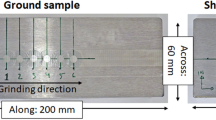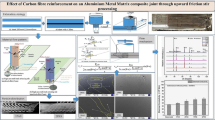Abstract
This study presents a comprehensive and comparative investigation on creep-feed grinding (CFG) of single crystal nickel-base turbine blade fir-tree roots with and without surface burn by using alumina abrasive wheels, in terms of tool wear, grinding force, temperature, and surface integrity. For both cases (i.e., with and without grinding burn), the low grinding ratios of below 1.6 are obtained, suggesting the rapid radial tool wear and the high difficulty for alumina abrasive wheels during grinding. Moreover, the coupling effects of blade root structure shape and grinding conditions are the most predominant at the second grinding step, which produces the largest grinding force and highest grinding temperature. Meantime, the defect-free surfaces and slight microstructural changes are found when grinding burn is absent. However, various defects are produced if grinding burn occurs, including the surface defects (i.e., high-temperature oxidation, micro-crack, and material smearing) and the subsurface defects (i.e., the white layer of 0.2–0.3 mm, material fracture, micro-crack, material peeling, and recrystallization). It is demonstrated that the thermo-mechanical-structural coupling effects influence significantly the profile grinding of turbine blade fir-tree root of the single crystal nickel-based superalloy (SX alloy). How to achieve the collaborative manufacturing of blade root structure shape and surface integrity poses great challenges to high-quality profile grinding.



















Similar content being viewed by others
References
Klocke F, Soo SL, Karpuschewski B, Webster JA, Novovic D, Elfizy A, Axinte DA, Tonissen S (2015) Abrasive machining of advanced aerospace alloys and composites. CIRP Ann Manuf Technol 64:581–604. https://doi.org/10.1016/j.cirp.2015.05.004
Cui X, Li CH, Zhang YB, Ding WF, An QL, Liu B, Li HN, Said Z, Shama S, Li RZ, Debnath S (2023) Comparative assessment of force, temperature, and wheel wear in sustainable grinding aerospace alloy using biolubricant. Front Mech Eng 18:3. https://doi.org/10.1007/s11465-022-0719-x
Song KK, Xiao GJ, Chen SL, Liu XT, Huang Y (2023) A new force-depth model for robotic abrasive belt grinding and confirmation by grinding of the Inconel 718 alloy. Robot Comput Integr Manuf 80:102483. https://doi.org/10.1016/j.rcim.2022.102483
Thakur A, Gangopadhyay S (2015) State-of-the-art in surface integrity in machining of nickel-based super alloys. Int J Mach Tools Manuf 100:25–54. https://doi.org/10.1016/j.ijmachtools.2015.10.001
Chen JJ, Fu YC, Qian N, Jiang HF, Ching CY, Ewing D, Dai CW (2021) Investigation on cooling behavior of axially rotating heat pipe in profile grinding of turbine blade slots. Appl Thermal Eng 182:116031. https://doi.org/10.1016/j.applthermaleng.2020.116031
Chamanfar A, Monajati H, Rosenbaum A, Jahazi M, Bonakdar A, Morin E (2017) Microstructure and mechanical properties of surface and subsurface layers in broached and shot-peened Inconel 718 gas turbine disc fir-trees. Mater Charact 132:53–68. https://doi.org/10.1016/j.matchar.2017.08.00
Klocke F, Seimann M, Binder M, Doebbeler B (2018) Milling of fir-tree slots in allvac 718 plus. Procedia CIRP 77:409–412. https://doi.org/10.1016/j.procir.2018.08.297
Ozaner OC, Karabulut S, Izciler M (2022) Study of the surface integrity and mechanical properties of turbine blade fir trees manufactured in Inconel 939 using laser powder bed fusion. J Manuf Process 79:47–59. https://doi.org/10.1016/j.jmapro.2022.04.054
Li QL, Ding K, Lei WN, Chen JJ, He QS, Chen ZZ (2021) Investigation on induction brazing of profiled cBN wheel for grinding of Ti-6Al-4V. Chin J Aeronaut 34:132–139. https://doi.org/10.1016/j.cja.2020.07.040
Welling D (2014) Results of surface integrity and fatigue study of wire-EDM compared to broaching and grinding for demanding jet engine components made of Inconel 718. Procedia CIRP 13:339–344. https://doi.org/10.1016/j.procir.2014.04.057
Klocke F, Welling D, Dieckmann J, Veselovac D, Perez R (2012) Developments in wire-EDM for the manufacturing of fir tree slots in turbine discs made of Inconel 718. Key Eng Mater 504–506:1177–1182. https://doi.org/10.4028/www.scientific.net/KEM.504-506.1177
Sharma P, Chakradhar D, Narendranath S (2015) Evaluation of WEDM performance characteristics of Inconel 706 for turbine disk application. Mater Des 88:558–566. https://doi.org/10.1016/j.matdes.2015.09.036
Zhang YB, Li CH, Ji HJ, Yang XH, Yang M, Jia DZ, Zhang XP, Li RZ, Wang J (2017) Analysis of grinding mechanics and improved predictive force model based on material-removal and plastic-stacking mechanisms. Int J Mach Tools Manuf 122:81–97. https://doi.org/10.1016/j.ijmachtools.2017.06.002
Liu MZ, Li CH, Zhang YB, Yang M, Gao T, Cui X, Wang XM, Xu WH, Zhou ZM, Liu B, Said Z, Li RZ, Sharma S (2022) Analysis of grinding mechanics and improved grinding force model based on randomized grain geometric characteristics. Chin J Aeronaut. https://doi.org/10.1016/j.cja.2022.11.005.Accessed16November2022
Spur G, Niewelt W (1994) Creep feed grinding of nickel-based alloys of industrial gas turbines. Prod Eng Res Devel 1(2):23–26
Ding WF, Xu JH, Chen ZZ, Su HH, Fu YC (2010) Grindability and surface integrity of cast nickel-based superalloy in creep feed grinding with brazed CBN abrasive wheels. Chin J Aeronaut 23:501–510. https://doi.org/10.1016/S1000-9361(09)60247-8
Rowe W (2017) Temperatures in grinding-a review. J Manuf Sci Eng Trans ASME 139:121001. https://doi.org/10.1115/1.4036638
Malkin S, Guo C (2007) Thermal analysis of grinding. CIRP Ann Manuf Technol 56:760–782. https://doi.org/10.1016/j.cirp.2007.10.005
Guo C, Campomanes M, Mcintosh D, Becze C, Malkin S (2003) Optimization of continuous dress creep-feed form grinding process. CIRP Ann Manuf Technol 52(1):259–262. https://doi.org/10.1016/S0007-8506(07)60579-4
Cao Y, Yin JF, Ding WF, Xu JH (2021) Alumina abrasive wheel wear in ultrasonic vibration-assisted creep-feed grinding of Inconel 718 nickel-based superalloy. J Mater Process Technol 297:117241. https://doi.org/10.1016/j.jmatprotec.2021.117241
Miao Q, Ding WF, Gu YL, Xu JH (2019) Comparative investigation on wear behavior of brown alumina and microcrystalline alumina abrasive wheels during creep feed grinding of different nickel-based superalloys. Wear 426–427:1624–1634. https://doi.org/10.1016/j.wear.2019.01.080
Poklad VA, Abysov IA, Starkov VK, Ryabtsev SA (2010) Surface-layer properties of turbine-blade tailpiece in deep grinding by highly porous wheels. Russ Eng Res 30:1132–1136. https://doi.org/10.3103/S1068798X10110134
Zhao ZC, Qian N, Ding WF, Wang Y, Fu YC (2020) Profile grinding of DZ125 nickel-based superalloy: grinding heat, temperature field, and surface quality. J Manuf Process 57:10–22. https://doi.org/10.1016/j.jmapro.2020.06.022
Tian CC, Wan Y, Li XK, Rong YM (2023) Study on the additively manufactured porous metal-bonded grinding wheel designed by octahedron lattice structure. Int J Adv Manuf Technol. https://doi.org/10.1007/s00170-022-10745-8.Accessed13January2023
Miao Q, Ding WF, Kuang WJ, Yang CY (2021) Study on grinding forces and surface quality in creep feed profile grinding of turbine blade root of nickel-based superalloy with microcrystalline alumina abrasive wheels. Chin J Aeronaut 34:576–585. https://doi.org/10.1016/j.cja.2019.11.006
Ichida Y (2008) Profile grinding of high-speed steel using ultrafine-crystalline cBN wheels. J Adv Mech Des Syst Manuf 2:385–395. https://doi.org/10.1299/jamdsm.2.385
Qian N, Fu YC, Chen JJ, Mashood KA, Xu JH (2020) Axial rotating heat pipe grinding wheel for eco-benign machining: a novel method for dry profile-grinding of Ti-6Al-4V alloy. J Manuf Process 56:216–227. https://doi.org/10.1016/j.jmapro.2020.03.023
Li BK, Miao Q, Li M, Zhang X, Ding WF (2020) An investigation on machined surface quality and tool wear during creep feed grinding of powder metallurgy nickel-based superalloy FGH96 with alumina abrasive wheels. Adv Manuf 8(2):160–176. https://doi.org/10.1007/s40436-020-00305-2
Ghosh S, Chattopadhyay AB, Paul S (2008) Modelling of specific energy requirement during high-efficiency deep grinding. Int J Mach Tools Manuf 48:1242–1253. https://doi.org/10.1016/j.ijmachtools.2008.03.008
Chen M, Lu XT, Sun FH, Xiang YC, Xue BY (2001) Studies on the grinding characteristics of directionally solidified nickel-based superalloy. J Mater Process Technol 116(2–3):165–169. https://doi.org/10.1016/S0924-0136(01)01024-X
Denkena B, Bouabid A, Kroedel A (2020) Single grain grinding: a novel approach to model the interactions at the grain/bond interface during grinding. Int J Adv Manuf Technol 107:4811–4822. https://doi.org/10.1007/s00170-020-05219-8
Kuang WJ, Miao Q, Ding WF, Zhao YJ, Zhao ZC (2021) Residual stresses of turbine blade root produced by creep-feed profile grinding: three-dimensional simulation based on workpiece-grain interacti0n and experimental verification. J Manuf Process 62:67–79. https://doi.org/10.1016/j.jmapro.2020.11.045
Sinha MK, Setti D, Ghosh S, Rao PV (2016) An investigation on surface burn during grinding of Inconel 718. J Manuf Process 21:124–133. https://doi.org/10.1016/j.jmapro.2015.12.004
Xiong J, Li J, Liu S (2010) Surface recrystallization in nickel base single crystal superalloy DD6. Chin J Aeronaut 23:478–485. https://doi.org/10.1016/S1000-9361(09)60244-2
Sun JY, Yang S, Yuan H (2021) Assessment of thermo-mechanical fatigue in a nickel-based single-crystal superalloy CMSX-4 accounting for temperature gradient effects. Mater Sci Eng A 809:140918. https://doi.org/10.1016/j.msea.2021.140918
Fleur RMN, Nowell D (2017) Evaluating the influence of residual stresses and surface damage on fatigue life of nickel superalloys. Int J Fatigue 105:27–33. https://doi.org/10.1016/j.ijfatigue.2017.08.015
Griffiths BJ (1987) Mechanism of white layer generation with reference to machining and deformation processes. J Tribol Trans ASME 109(3):525–530. https://doi.org/10.1115/1.3261495
Ranganath S, Guo C, Hegde P (2009) A finite element modeling approach to predicting white layer formation in nickel superalloys. CIRP Ann Manuf Technol 58:77–80. https://doi.org/10.1016/j.cirp.2009.03.109
Ding WF, Zhang LC, Li Z, Zhu YJ, Su HH, Xu JH (2017) Review on grinding-induced residual stresses in metallic materials. Int J Adv Manuf Technol 88(9–12):2939–2968. https://doi.org/10.1007/s00170-016-8998-1
Funding
This work was supported by the Natural Science Foundation of Jiangsu Province (Grant No. BK20210866), Natural Science Foundation of the Jiangsu Higher Education Institutions of China (Grant No. 21KJB460021), and China Postdoctoral Science Foundation (Grant No. 2022M721623).
Author information
Authors and Affiliations
Contributions
All the authors contributed to the study conception and design. Material preparation, data collection, and analysis were performed by Qing Miao. The first draft of the manuscript was written by Qing Miao, and all the authors commented on previous versions of the manuscript. All the authors read and approved the final manuscript.
Corresponding author
Ethics declarations
Consent to participate
It is confirmed that all the authors are aware and satisfied of the authorship order and correspondence of the paper.
Consent for publication
The publisher has the permission of the authors to publish the given article.
Conflict of interest
The authors declare no competing interests.
Additional information
Publisher's note
Springer Nature remains neutral with regard to jurisdictional claims in published maps and institutional affiliations.
Rights and permissions
Springer Nature or its licensor (e.g. a society or other partner) holds exclusive rights to this article under a publishing agreement with the author(s) or other rightsholder(s); author self-archiving of the accepted manuscript version of this article is solely governed by the terms of such publishing agreement and applicable law.
About this article
Cite this article
Miao, Q., Lu, M., Ding, W. et al. Creep-feed grinding of single crystal nickel-base turbine blade fir-tree roots: tool wear, grinding force, temperature, and surface integrity. Int J Adv Manuf Technol 126, 1453–1470 (2023). https://doi.org/10.1007/s00170-023-11188-5
Received:
Accepted:
Published:
Issue Date:
DOI: https://doi.org/10.1007/s00170-023-11188-5




